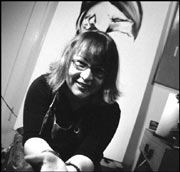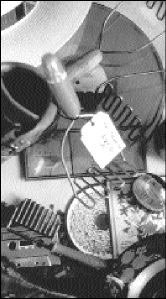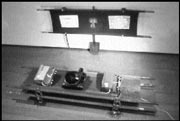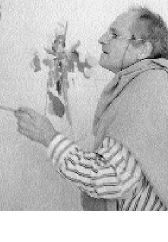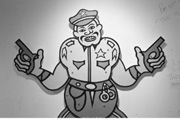WHAT IS ART?
Rainier Square, 1333 Fifth, second floor, reception 5-10 p.m. Fri., Feb. 1 runs Feb. 1-Mar. 1
IT ALL STARTED last year on a trip to Germany, when Maria Medina found herself hiking up a hill in the dark toward the ruins of Hardenburg Castle. “It was a strange world, totally removed from reality,” she recalls, obviously enchanted. “The castle itself was lit with undulating projected images, and you entered through an old drawbridge. Inside was all this amazing art and hoards of DJs.” Seeking a good party, she had stumbled upon phase one of “What Is Art?” hosted by Bionic, a German outfit that puts on ravelike art shows. It was here that Medina chanced to meet Jens Damgen, Bionic’s mastermind. The two hit it off, and he invited her to present her paintings in a 2003 incarnation of the exhibition.
In trademark Medina style, she inflated the project tenfold and now plans to turn “What Is Art? 2003” into an international collaboration involving 11 emerging artists from Seattle as well as artists from France, Italy, Germany, and Greece. A preview of the project opens this weekend at Rainier Square. “It’s an introduction,” she explains, “a chance for the Seattle community to meet the artists and find out what type of art will be representing Seattle and the U.S. next year when we take the show to Germany.” With plane tickets, art shipping, and other major expenses to cover, Medina says, “I want to get a buzz going in Seattle so we can get funders interested.” She is also organizing a “What Is Music?” event that will bring European and American DJs together in Seattle this spring.
Though she’s 25, Medina could easily pass for 17. A giggly, small, rather cuddly looking person outfitted with lilac-tinted eyeglasses and candy-colored clothing, she’s nonetheless a pretty effective wheeler-dealer, unabashedly referring to herself as an “idea broker.”
She certainly knows how to get the limelight shined her way. In the late ’90s, she was doing live painting at the (now defunct) Velvet Elvis and got noticed by Vincent Balestri, star of a one-man show about Jack Kerouac. Medina ended up doing live painted interpretations of the play for his audiences.
Her work is currently on view in the Women in Cinema Film Festival art show at Richard Hugo House. With a smooth, polished, meticulous look, it combines historical references to the collage style of the Dadaists with contemporary elements drawn from hip-hop and graffiti culture. Most striking are her juxtapositions of female bodies with the architecture and harsh emblems of urban culture and technology.
Medina says the goal of “What Is Art?” is to create opportunity for emerging artists, to appropriate the powers of established curators in determining what is art. There’s no real theme to the exhibition; in fact, Medina’s been accused of being a curatorial communist. (She recently co-curated “Stepping From the Shadows,” an exhibition of graffiti art that closed last week at the IMC Gallery.) “I want to create a comfortable experimental atmosphere,” she explains. “I ask each artist to be their own art director and use this project to push the limits of their work.”
Much of the art deals with the intersection of humanity and technology. The exhibition at Rainier Square includes installation work by Paul Davies, who uses technology as a medium and “dissects its insipid cultural influences.” “Picture this,” says Medina, “a grocery cart with a small robot or metal animal attached to it.” Andrew Trosper DeRoux’s sculptural paintings are made with resin, epoxy, and dry pigments; the resulting images pay homage to the rhythm of computer chips and piping. The exhibition will also include experimental photography, paintings, and video. Maktub’s Reggie Watts is acting as music director/producer.
“I want to re-create the collaborative relationships that fueled the great art movements of the past: Dadaism, Italian futurism, surrealism, even Impressionism,” Medina says. “In today’s climate, while everyone on the globe is connected, artists often work in isolation, having no academy or prevalent movement against which to join forces.” Medina would be happy if the final outcome of “What Is Art?” were an international database that emerging artists could use to connect with one another and forge their own way as organizers. “Instead of waiting for something like this to happen, I just made it up,” she explains.
